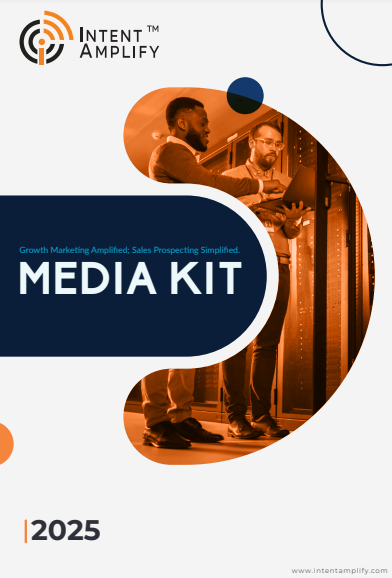
What are the Key Elements of a Successful Lead Generation Campaign?
- Last updated on: August 7, 2025
Lead generation isn’t just another marketing term people know around. It’s the heartbeat of modern business. You can have the slickest website, the best product in your category, and a killer sales team – but if leads aren’t flowing in consistently, you’re running on fumes.
That said, running a lead generation campaign that works? That’s a different game entirely, requiring strategy and precision. There are too many companies that launch campaigns with big expectations and fancy tools… only to get radio silence in return. The truth is, successful lead generation is equal parts art, science, and good human intuition. Before going into what makes a lead generation campaign click? Let’s first know what defines a successful lead generation campaign.
How Do We Define a Successful Lead Generation Campaign at Intent Amplify?
At Intent Amplify, we define a successful lead generation campaign as one that brings in not just leads but the right leads. It’s not about vanity metrics or bloated contact lists. It’s about quality, intent, and conversion potential.
For us, success means attracting prospects who genuinely need what you offer, are a strong fit for your product or service, and are likely to move through the funnel with the right nudge. A campaign should support your sales goals, reflect your brand voice, and open the door to meaningful conversations – not just clicks and downloads.
But we don’t stop there. A winning campaign also needs to be measurable. If you can’t tie your lead gen efforts to sales activity or pipeline growth, something’s off. We consider a campaign successful when:
- Leads are highly engaged and ready to talk
- Sales teams see real value in the handoffs
- There’s measurable ROI and momentum
Your lead gen should create business opportunities – not busywork. That’s how we see it at Intent Amplify. Now, let’s know about the key elements of a successful lead generation campaign
1. Crystal-Clear Target Audience
Before you draft a headline, schedule a campaign, or even pick a platform – you’ve gotta know who you’re talking to.
Sounds basic, right? But you’d be surprised how many campaigns fall flat because the audience is too broad or poorly defined. “Decision-makers in tech” isn’t a target persona. “Mid-level IT managers in SaaS companies with 50-200 employees, struggling with cloud migration”? Now we’re talking.
Creating buyer personas is essential, but more importantly, updating them is crucial. What mattered to your ideal customer 12 months ago may not matter.
2. An Irresistible Offer
Nobody gives up their email for a “generic newsletter” anymore. People trade their contact info when they feel like they’re getting something valuable in return. That could be:
- A free audit or consultation
- A gated eBook packed with real insights (not fluff)
- An on-demand webinar solving a very specific pain point
- An ROI calculator that helps them sell your solution to their boss
The trick? Your offer has to hit a nerve. It needs to speak to a real problem and promise a tangible benefit.
3. Landing Pages That Convert, Not Confuse
Your landing page is where everything comes together. Think of it as a digital handshake – first impressions matter. It should be clean, focused, and built to guide people toward one clear action.
What works:
- A clear headline that immediately communicates value
- A short subheading that addresses a pain point
- Social proof (testimonials, logos, reviews)
- Zero distractions (no nav bars, minimal links)
- A CTA button that doesn’t say “Submit” (seriously, nobody likes that word)
Don’t make users guess what they’re supposed to do. Keep it obvious, simple, and benefit-driven.
4. Multi-Channel Promotion Strategy
Even the best offer will flop if no one sees it. That’s why a strong lead gen campaign includes a solid distribution plan. Don’t rely on a single channel – leverage a mix based on where your audience hangs out. Here’s a basic idea of how that could look:
- Email marketing for nurturing warm contacts
- LinkedIn Ads for B2B targeting
- Google Search Ads to catch high-intent traffic
- Content marketing to support SEO over time
- Retargeting for those who didn’t convert the first time
Also, don’t underestimate organic posts. A personal LinkedIn post from your founder can outperform a paid ad if it hits the right emotional note.
5. Lead Capture That Feels Effortless
If your form looks like a tax return, your leads will bounce. No one enjoys filling out 12 fields just to get a download link. The more friction you introduce, the fewer conversions you will achieve. It’s as simple as that.
Use smart tools like progressive profiling or social login options (e.g., “Sign in with LinkedIn”) to reduce effort. And in case you need to ask additional questions, provide an explanation for it. For instance: “We ask for your company size so we can send you the most relevant resources.”
6. A Solid Lead Scoring & Qualification Framework
Not all leads are created equal. You don’t want your sales team wasting time on people who downloaded a freebie out of curiosity and have zero intent to buy. This is where lead scoring comes in. Assign points based on behavior and demographic fit:
- Opened an email? +5 points.
- Attended a webinar? +15 points.
- Works at a target company? +20 points.
Use tools like HubSpot, Salesforce, or Zoho to automate this process and sync it with your CRM. Better yet? Align with your sales team early on. Agree on what qualifies as “sales-ready” so there’s no back-and-forth later.
7. Automated (Yet Personalized) Nurture Flows
Here’s the thing about leads: most of them won’t convert right away. And that’s perfectly fine – if you’ve got a nurture system in place. You want to stay top-of-mind without being annoying. A good email sequence should feel like a conversation, not a campaign. For example:
- Email 1: Recap the value of the resource they downloaded
- Email 2: Provide a relevant case study or blog article.
- Email 3: Send a simple question or invite someone to a webinar.
- Email 4: Provide a complimentary consultation or special offer
Don’t make it all about selling. Mix in value, education, and even a bit of personality.
8. A/B Testing Culture
The biggest enemy of growth? Assumptions.Just because you think something will work doesn’t mean it will. That’s why testing is non-negotiable. You should be running A/B tests on:
- Subject lines
- Landing page copy
- CTA button colors and wording
- Ad creatives
- Email send times
But don’t test too many things at once – keep it simple, and measure results methodically. Sometimes, even a single word change can double your conversions. I’ve seen it happen.
9. Tight Sales & Marketing Alignment
This one’s big, and it’s often overlooked. If your sales team isn’t looped in from day one, you’ll end up with leaks in your funnel. Marketing might think a lead is warm, while sales sees it as a waste of time. You need regular feedback loops:
- Are the leads qualified?
- What messaging is resonating on calls?
- Where are leads dropping off?
Weekly syncs, shared dashboards, and joint KPIs can make a huge difference.
10. Data-Driven Optimization
At the end of the day, the stats don’t lie. You can feel like a campaign is going well – but unless you’re tracking the right metrics, it’s just an idea.
Here’s what you should be monitoring:
- Cost per lead (CPL)
- Conversion rate (landing page, form, email, etc.)
- Lead quality score
- Sales-qualified lead (SQL) conversion rate
- ROI per channel
But don’t just look at dashboards. Use the data to act. Pause underperforming channels. Double down on what’s working. Tweak messaging based on open rates and feedback.
Common Lead Generation Mistakes (and How to Avoid Them)
Lead generation can be tricky, even for seasoned marketers. And while every campaign is a learning opportunity, some mistakes tend to pop up again and again. The good news? Most are easy to fix once you know what to watch for.
- Casting Too Wide a Net
Trying to attract everyone usually results in engaging no one. If your messaging is vague or your targeting is too broad, you’ll get unqualified leads that waste time and budget. Focus on a tight, well-defined ICP (ideal customer profile) instead. - Relying on One Channel
Putting all your eggs in one basket – say, just running LinkedIn Ads – limits your reach and puts your campaign at risk if that channel underperforms. Mix it up with email, SEO, paid search, social, and even outbound. - Weak Call-to-Actions (CTAs)
A CTA like “Learn More” doesn’t cut it anymore. It’s forgettable and doesn’t tell the user what they’re getting. Use action-driven, benefit-focused CTAs like “Download the Free Playbook” or “Get Your Personalized Audit.” - No Follow-Up Strategy
One of the biggest silent killers of lead gen campaigns is failing to follow up. If a lead fills out a form and doesn’t hear from you for days (or ever), the opportunity fades. Automation helps, but personalization seals the deal. - Ignoring the Data
If you’re not measuring and optimizing based on real-time results, you’re flying blind. Look at which touchpoints are converting, which emails are being opened, and which leads turn into revenue.
Key Metrics to Track in Every Lead Generation Campaign
Even the most creative campaigns mean little without the numbers to back them up. At Intent Amplify, we always say: If you can’t measure it, you can’t improve it or repeat it at scale. Here are the core KPIs every lead generation campaign should monitor:
- Cost per Lead (CPL): How much are you spending to acquire each lead? This helps determine ROI per channel and overall budget efficiency.
- Lead Quality Score: Not all leads are sales-ready. Scoring helps separate high-intent prospects from casual clickers who are unlikely to convert.
- Conversion Rate: Track how many people take the desired action – whether it’s filling out a form, downloading an asset, or booking a call.
- Lead-to-Customer Rate: How many leads become paying customers? This tells you how aligned your campaign is with sales outcomes and revenue goals.
- Time to Follow-Up: How fast is your team reaching out to new leads? The sooner the better – ideally within minutes.
You don’t need to track everything – just focus on the metrics that align with your goals. And check them regularly. Too many marketers “set and forget,” then wonder why results stall.
Final Thoughts: Don’t Overcomplicate It
A successful lead generation campaign isn’t about using the latest tools or following every tip you come across. It’s about getting the fundamentals right:
- Know your audience inside out
- Give them something they genuinely want
- Make the journey easy and human
- Follow up with empathy, not just automation
- And always, always improve based on feedback
It does take patience, creativity, and a willingness to test, learn, and evolve. If you’re looking to build a high-performing lead generation engine that drives actual results, Intent Amplify can help. We blend human-first strategy with powerful automation to help you scale smarter.
FAQs
1. How to know when a lead generation campaign is working?
Look at the metrics: conversion rate, CPL (cost per lead), and how many leads turn into real conversations or sales. If your metrics are flat or going down, then it is time to optimize.
2. What is the best platform for B2B lead generation?
For B2B, LinkedIn is a goldmine; however, do not ignore the email marketing, Google Ads, or webinars, because your ideal platform is wherever your audience spends their time.
3. How many sales touches does it take to convert leads?
About 6-8. That makes nurturing an important function. Don’t give up after your first email; keep being helpful and persistent.
4. Should I buy a lead list?
Certainly not. Most purchased lists violate GDPR or other privacy laws and hardly lead to any sales conversion. It’s better to build your list organically through gated content or intent-based outreach.
5. What is the difference between a Marketing Qualified Lead and a Sales Qualified Lead?
A Marketing Qualified Lead expresses interest (downloads, clicks, etc.); on the other hand, a Sales Qualified Lead is ready for a sales conversation, fitting your ICP.




